�
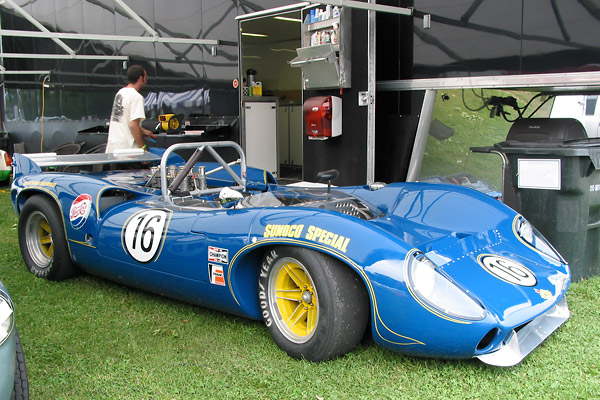
�
Bill Thumel's Lola T70 Mk3 Race Car, in 59 Large Photos
�The Origin of Lola Racing Cars
��
Eric Broadley began designing and building racecars in the 1950's. In 1958 he opened �
a small manufacturing facility in Bromley, at the southeast edge of London, to produce �
cars for various classes of international competition. In 1961 Broadley's shop �
took the name "Lola" and Broadley accepted a challenge from Reg Parnell, owner of �
the Bowmaker Racing Team to design a car with which they'd compete in Formula One.�
The resulting design was moderately successful. Driving the new Lola "Mark 4", John �
Surtees managed to qualify in pole position for the 1962 Dutch Grand Prix, but he�
retired from the race after only eight laps. Such was Lola's success that year: when �
Surtees finished, he finished quickly! Surtees only completed five of ten championship �
races, but that was enough for him to finish fourth in championship points. Teammate �
Roy Salvadori didn't manage to finish a single championship series race in his Mark 4. �
�
Concurrently with working to refine the Mark 4, Broadley starting building a �
mid-engined racecar which he called the "Mark 6". It was designed around the small �
block Ford V8. The Mark 6 so impressed Ford that they contracted Broadley through �
1964 to help Roy Lunn develop their famous "GT40" model. The GT40 project was focused �
on beating Ferrari at LeMans. Working with Ford assured Broadley's reputation and �
positioned him for even greater success building his own racecars. When he completed �
his contract with Ford, Broadley went quickly to work designing the Lola T70.�
�
Unlike the Ford GT 40, which has an all-steel full monocoque chassis, the T70 design �
utilized a mix of steel and aluminum in an "open monocoque" construction. In other �
words, the cockpit area is principally an open-topped sheetmetal punt, with strong �
steel bulkheads at front and rear. Tubular steel is integrated into the structure �
around the engine. The very earliest T70's utilized spot-welded steel for the punt, �
but that was changed to riveted aluminum with production of the Mk2 version. (Initially, �
the T70's principal rival was the McLaren "M1A" which utilized a steel space frame �
throughout.) The T70 was engineered to easily support either Ford or Chevy small block �
V8 engines. With relatively minor modifications, it would ultimately support Ford or �
Chevy big blocks too. �
�
Eric Broadley commissioned John Frayling to style the fiberglass exterior bodywork. �
Frayling was already well known, particularly for his design of the Lotus Elite. �
�
The Lola T70 design immediately attracted the interest of Formula One's 1964 World �
Champion, John Surtees. Surtees took time off between other driving responsibilities �
to test pilot the prototype T70 and assist with its development through early 1965. �
With Lola's support, Surtees would ultimately drive his own T70 to win the Can-Am �
championship in 1966. �
Please support the sponsoring companies who make www.BritishRaceCar.com possible, including:
� �
 �
�
�
�
Lola T70 in North American Competition, 1966
��
In North America, Lola T70's competed in several racing series. Specifically, they �
competed in the United States Road Racing Championship ("USRRC") series until �
the series was discontinued after the 1968 season. Lola T70's also competed in the �
Canadian-American Challenge Cup series (aka: "Can-Am"), which was co-sanctioned �
by SCCA and by the Canadian Auto Sports Clubs ("CASC"). The Can-Am series ran �
from 1966 through 1974. Lola T70's occasionally participated in World Sportscar �
Championship events, such as the 24 hours of Daytona and the 12 hours of Sebring. �
�
For 1966, Roger Penske Racing was a one-driver team. Roger Penske had only just �
retired from his own driving career, and he recruited Mark Donahue to drive for him. �
Donahue was provided a T70 Mk2 with a 427cid big block Chevy engine. �
The team hoped that the large engine would provide them with an unfair advantage, �
but quickly learned that it was actually a handicap. They particularly had problems �
with bearing failures, which may have been attributable to its wet sump oil system. �
At any rate, the big block engine was soon found less suitable than the small block �
Chevy for enduring extended high-rpm use. �
�
Donohue's first race in the Penske Racing Lola T70 was in Round 5 of the USRRC series �
at Watkins Glen in June 1966. He qualified third, but the race went badly: Donohue's �
big block Lola T70 was involved in an accident, followed by a fire, and was a total-loss.�
A second Lola T70 was procured for Donohue's next race. This one was equipped with a �
333cid Chevy small block built by TRACO Engineering. It was immediately successful! �
Driving the new Lola T70, Mark Donohue won Round 6 of the USRRC series at Pacific �
Raceways in Kent Washington on July 30, 1966. Following that race, the Penske team �
tested the car extensively and ended up developing a chin spoiler and a rear wing. �
(The rear spoiler became obsolete.) They also fitted a larger rear sway bar. These �
improvements were installed in time for Round 7 (August 29, at Mid-Ohio) but Donohue �
retired early from the race due to mechanical problems. The Penske �
team decided to sit-out the final round of the 1966 USRRC series (September 4 at Road �
America), in favor of tire testing and preparation for the first race of the 1966 Can-Am �
series. Donohue's single race win placed him eighth in 1966 USRRC championship points. �
�
With what they had learned in USRRC racing, the Penske team was ready to attack �
Can-Am's six-round schedule. They won one race, at Mosport in Ontario, and they earned�
championship points by finishing within the top six positions of four other races. �
They completed the 1966 Can-Am season second in championship points to John Surtees, �
who won 3 races in his small block Chevy powered Lola T70 Mk2 (at Mont-Tremblant, �
Riverside, and Las Vegas). Dan Gurney won one Can-Am race (at Bridgehampton) in a Lola �
T70. In fact, the only non-T70 win of the season was Phil Hill's victory in a �
Chaparral 2E at Laguna Seca. �
�
Enjoying this article? www.BritishRaceCar.com is partially funded through generous support from readers like you!
�
To contribute to our operating budget, please click here and follow the instructions.
�
(Suggested contribution is twenty bucks per year. Feel free to give more!)�
History of Lola T70 Car Number "SL73/126"
��
For 1967, Roger Penske recruited George Follmer as a second driver. George Follmer �
had previously driven a Lola T70 Mk2 for John Mecom Racing, placing 5th at Mont-Tremblant �
and at Riverside in 1966. By some accounts the car shown here, chassis number SL.73/126,�
was purchased specifically for George Follmer. By other accounts, it was a back-up car �
originally purchased for Donahue. It's well documented that Follmer drove SL.73/126 in �
the final three races of the 1967 Can/Am series. (Some sources suggest that he drove �
this particular T70 in all six races1.) Follmer's results:
�
| Round: Venue (Event) | Race Date | Qualified | Finished | Points |
| 1: Road America (Road America Can-Am) | September 3, 1967 | 4th | 18th | 0 |
| 2: Bridgehampton (Chevron GP) | September 17, 1967 | 5th | 3rd | 4 |
| 3: Mosport (Players 200) | September 23, 1967 | 7th | 6th | 2 |
| 4: Laguna Seca (Monterey GP) | October 15, 1967 | 11th | 3rd | 4 |
| 5: Riverside (L.A. Times GP) | October 29, 1967 | 12th | 6th | 1 |
| 6: Las Vegas (Stardust GP) | November 12, 1967 | 12th | DNF (broken shifter) | 0 |
| Season Final: | 6th | 10 |
�
By 1967 the Lola T70 was no longer the state-of-the-art in Can-Am racing. The new car to beat �
was the McLaren M6A with small block Chevy engine, as driven by Bruce McLaren and Denny Hulme. �
The M6A was just a little bit narrower (53" track vs. 58"), shorter (91" wheelbase vs. 95"),�
and lighter (reportedly about 50#). It probably had little appreciable advantage in power or �
aerodynamics, although McLaren apparently put relatively more priority on generating downforce�
than reducing drag. However, the McLaren M6A's rear suspension was well developed through extensive �
co-development with Goodyear to keep wider, stickier tires flat on the pavement. In 1967, �
Can-Am became known as "The Bruce and Denny Show". They completely dominated, with five �
wins between them. The Lola T70 provided solid second-tier performance: John Surtees finished �
third in points with one race win, and Mark Donahue finished fourth in points with two �
second-place finishes.�
�
Roger Penske Racing sold SL.73/126 to Jerry Hansen in early November 1967. If Jerry Hansen's�
name is familiar, it might be because Hansen won 27 SCCA championships. Hansen's crew chief, �
Scotty Beckett, traveled to Penske's shop and quickly helped rebuild the newly purchased car�
so it could be qualified to race in the 1967 SCCA Runoffs at Daytona. Everything came together�
and in the final qualifying session Hansen put the Lola on the pole. He followed through by�
winning the CSR class (on November 26). In the process, he set a lap record at 194.6mph. �
Hansen ultimately drove the Lola to victory in all five of the races he entered it in.�
�
In 1968 Jerry Hansen sold SL.73/126 to Dick Kantrud, who drove it in to a fourth place�
finish in the 1968 SCCA CSR class championship. For 1969, Kantrud installed a 440cid �
big block Chevy engine with Bosch timed-port mechanical fuel injection, Penske dry sump,�
and wider wheels and tires. Thus equipped, Dick Kantrud Can-Am results driving SL73/126 �
(under number "97") included a 13th place finish at Road America in 1969 and a 14th place �
finish at Donnybrooke in 1970. The fabulous but ageing racecar was then retired from �
serious competition. It competed occasionally through 1974. �
�
In 2005, a disassembled collection of SL.73/126's parts was purchased by current owner Bill Thumel. �
The purchase included the original punt and number plate, an original set of Lola body panels, �
original Lola magnesium wheels, and many cardboard boxes of miscellaneous used parts. A complete �
restoration of SL.73/126 has subsequently been completed by Bill's shop, "Abacus Racing" �
in Virginia Beach, Virginia.�
�
�
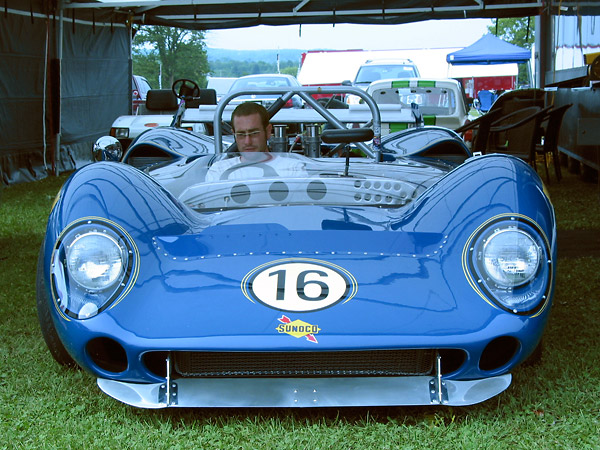
�
Jared Keller (shown here) coordinated restoration and race-prep of SL.73/126 for Abacus Racing.
�
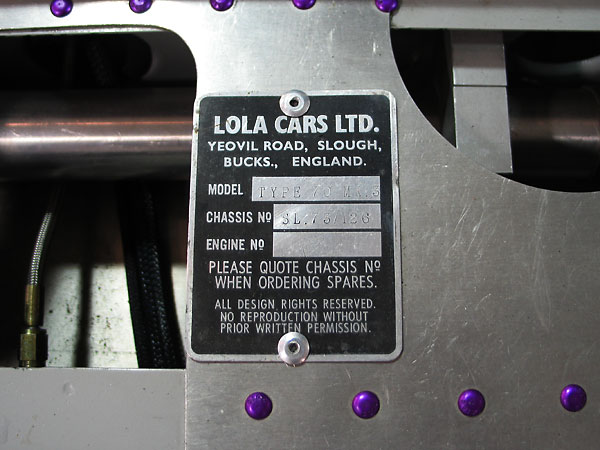
�
Lola Cars Ltd., Yeovil Road, Slough, Buckinghamshire, England.
�
Model: Type 70 Mk3 / Chassis No.: SL.73/126 / Engine No.: (blank)
�
Features and Specifications
�| Engine: | �small block Chevy V8 (333 cid), quite similar to the one �
originally supplied for the car by TRACO Engineering. Penske cast �
magnesium intake manifolds (one of only two sets of their kind in existence).�
Weber 48 IDA carburetors (x4), custom bored to 52mm. Solid lifters.�
MSD "Crab Cap" distributor (part# 8486). Mallory "Blaster 2" coil �
(painted black to replicate the original coil's appearance.)�
Mocal oil coolers (2 16-row coolers, plumbed in parallel.) | �
| Exhaust: | �custom fabricated reproductions of the original 4-into-1, step-up headers, with Jet-Hot ceramic coating. | �
| Transmission: | �Hewland LG500 transaxle (4-speed version). Mocal oil cooler (16-row).�
Girling master cylinder. | �
| Front Susp.: | �original outboard-mounted KONI adjustable coilover shock absorbers �
(rebuilt by KONI). Cast magnesium uprights. Adjustable anti-sway bar. | �
| Rear Susp.: | �original outboard-mounted KONI adjustable coilover shock absorbers �
(rebuilt by KONI). Cast magnesium uprights. Adjustable anti-sway bar. | �
| Brakes: | �(master) Girling master cylinders with bias bar. Wilwood residual pressure valves, � (front) Girling calipers and 12.5" vented rotors, � (rear) Girling calipers and 12.5" vented rotors. | �
| Wheels/Tires: | �Lola magnesium wheels (15x8" front and 15x10" rear) with�
Goodyear "Blue Streak" tires (15x6.00 front and 15x8.00 rear). | �
| Instruments: | �(left-to-right)�
Stewart Warner fuel level,�
voltmeter,�
engine oil temperature, �
water temperature,�
tachometer, and�
engine oil pressure gauges.�
(A fuel pressure gauge is mounted next to a pressure regulator, near the fuel cell.) | �
| Fuel System: | �original T70's were equipped with two rubber fuel bladders, with a combined capacity �
of 60 gallons (~370 pounds). | �
| Dimensions: | �95" wheelbase and 58" track (front and rear). 1600 pounds (dry). | �
Engine Installation
��
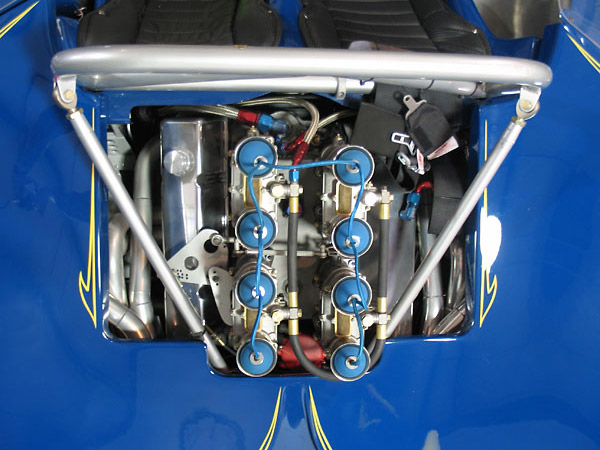
�
Small block Chevy V8 (333 cid).
�
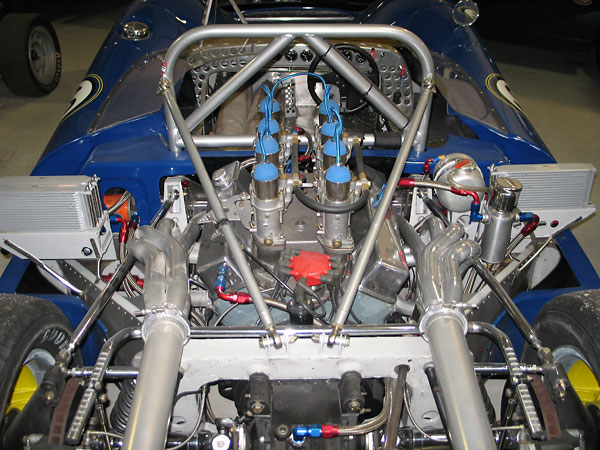
�
The roll hoop has been raised several inches for modern vintage racing safety requirements.
�
Its dual rearward braces are also a modern addition.
�
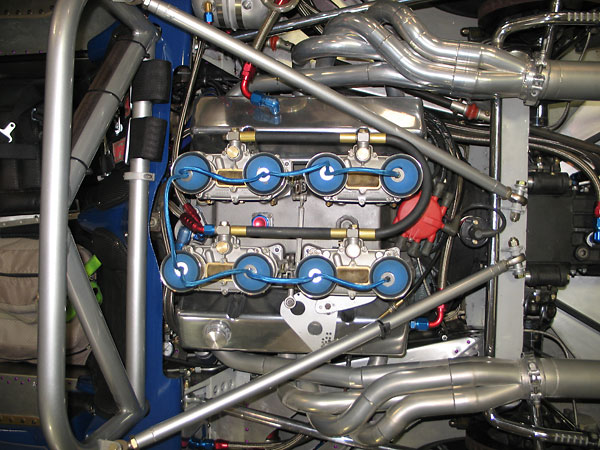
�
The 4-into-1 step-up headers are beautifully made reproductions, with modern Jet-Hot ceramic finish.
�
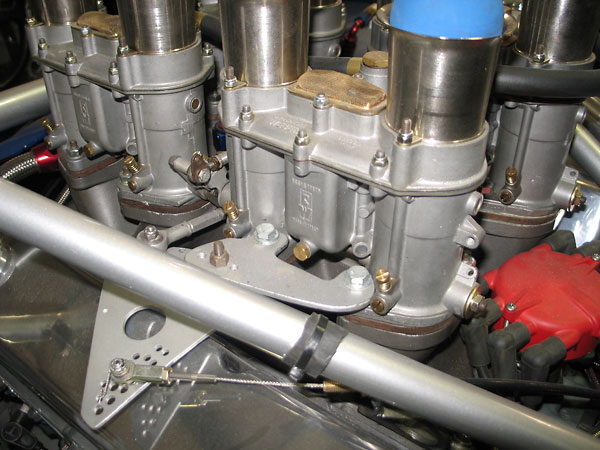
�
The throttle linkage is original to the car.
�
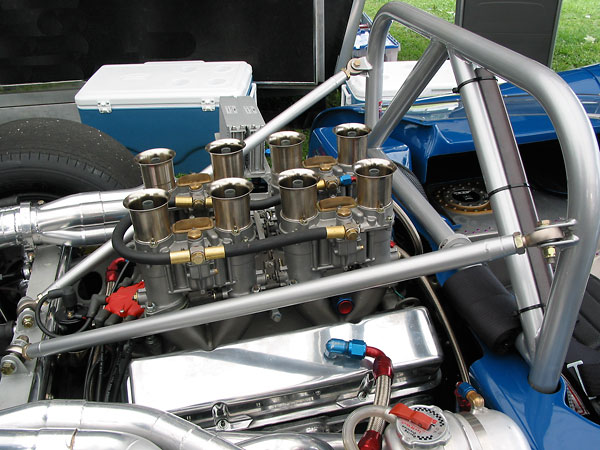
�
The Penske cast magnesium intake manifolds are one of only two sets of their kind in existence.
�
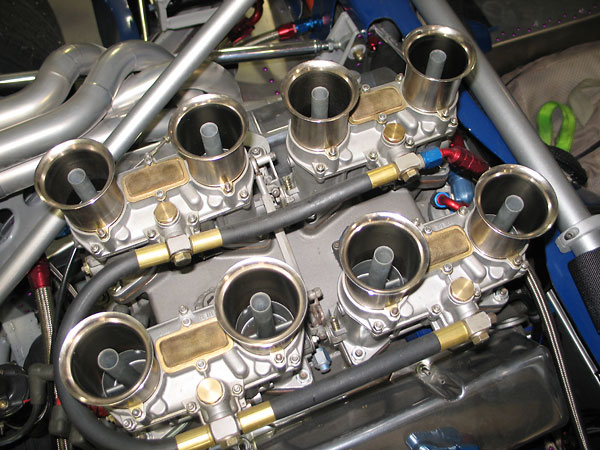
�
�
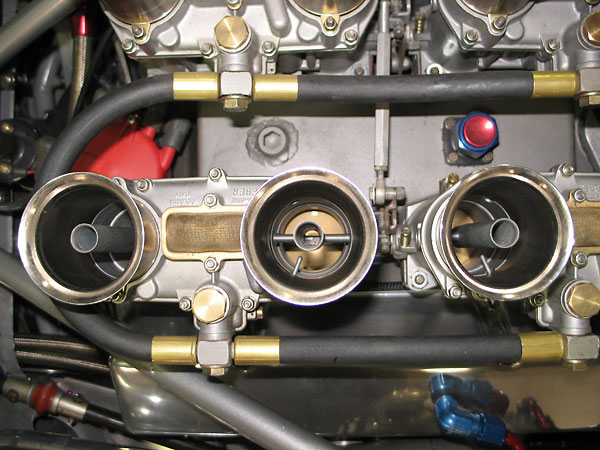
�
The Weber carburetors have been bored-out from 48mm to 52mm.
�
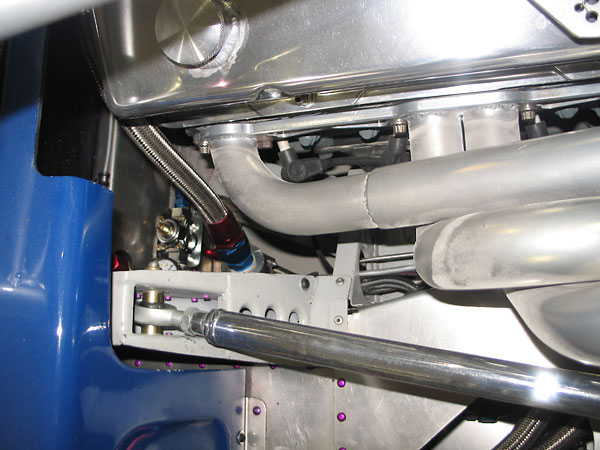
�
Fuel pressure gauge and regulator.
�
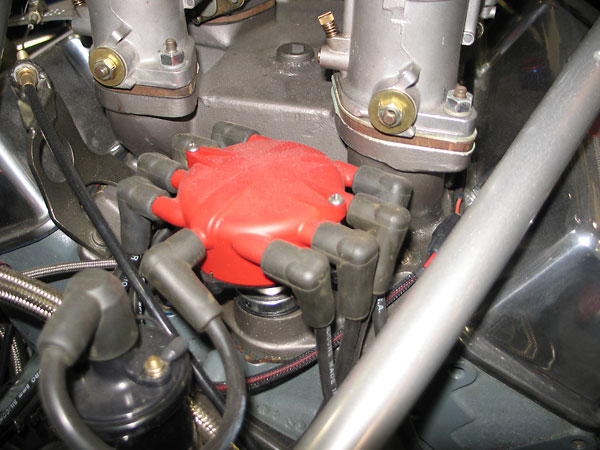
�
MSD "Crab Cap" distributor.
�
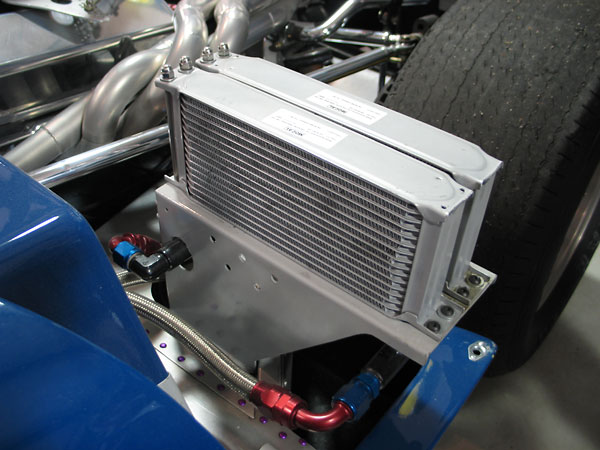
�
Twin 16-row Mocal oil coolers for engine oil (plumbed in "parallel").
�
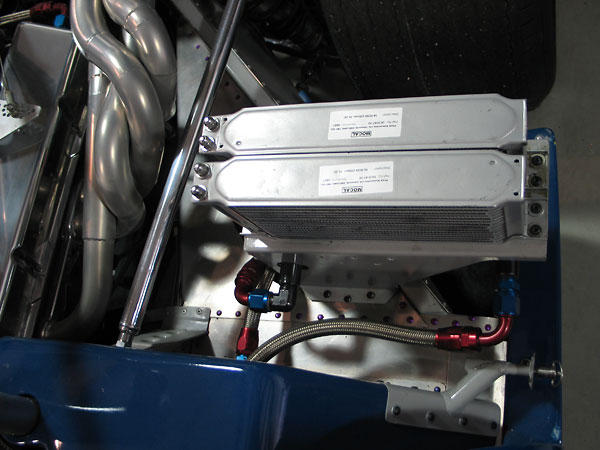
�
�
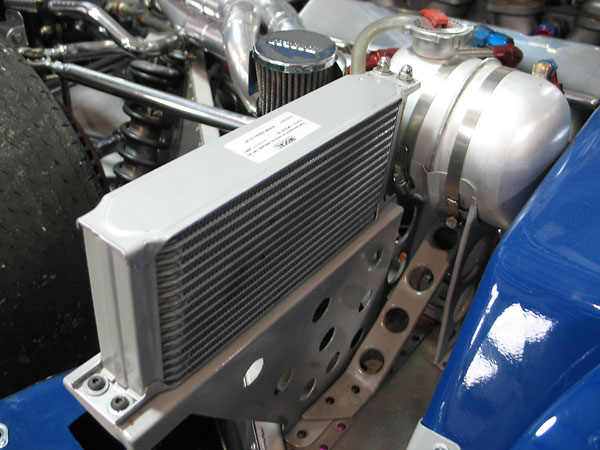
�
(Not to be confused with the single Mocal 16-row cooler for the Hewland transaxle's oil.)
�
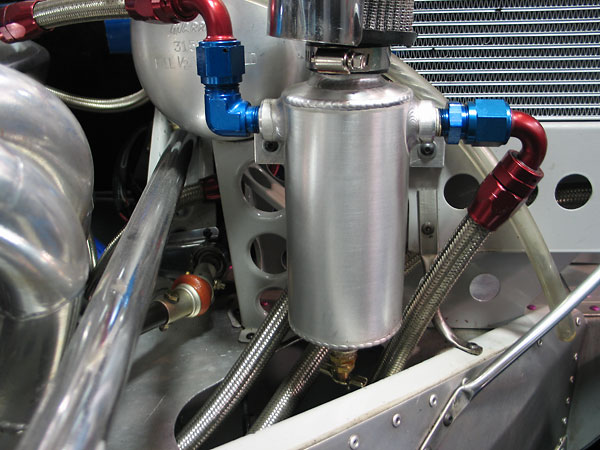
�
Breather tank for the lubrication system.
�
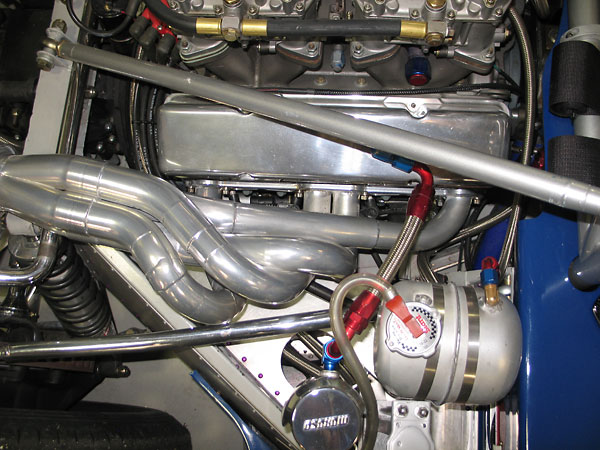
�
Aluminum header tank for the cooling system.
�
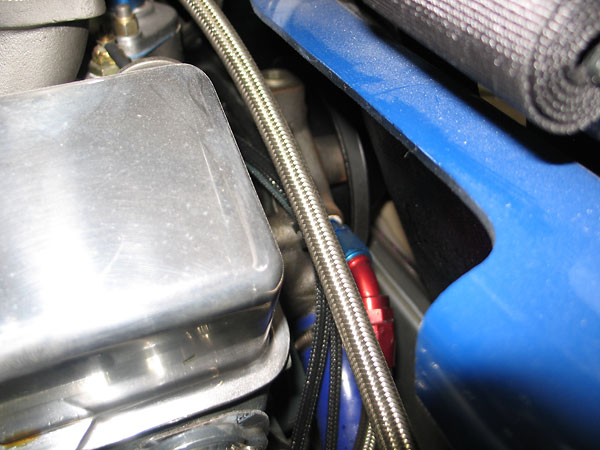
�
Engine driven water pump.
�
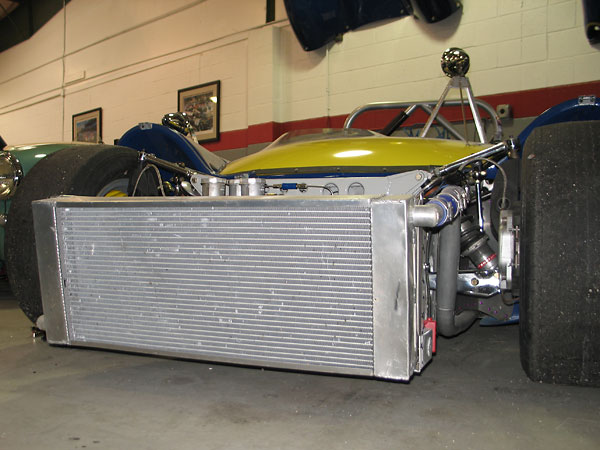
�
�
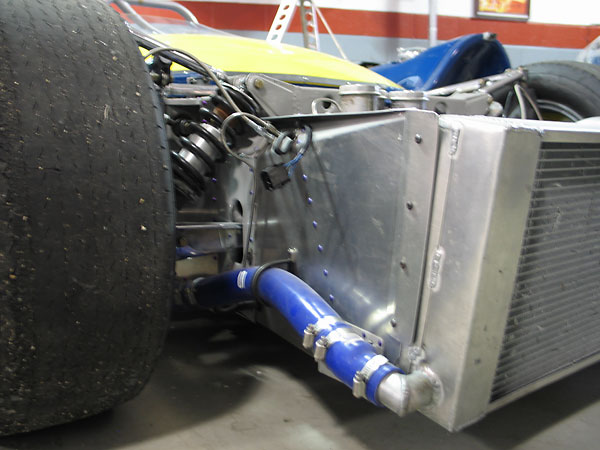
�
�
 �
�
�
�
Front Suspension / Steering / Brakes
��
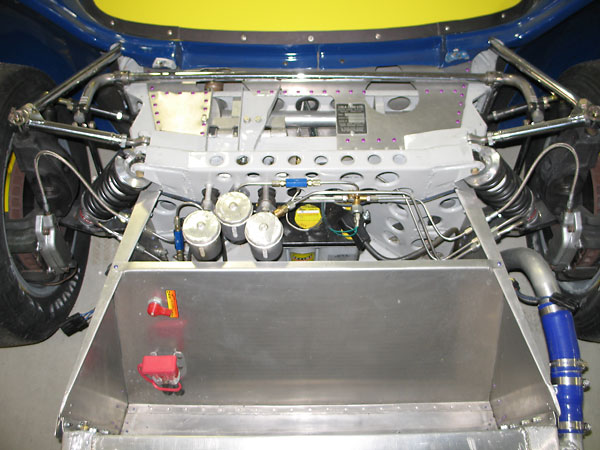
�
A strong, elaborate fabricated steel crossmember supports the front suspension mounting points.
�
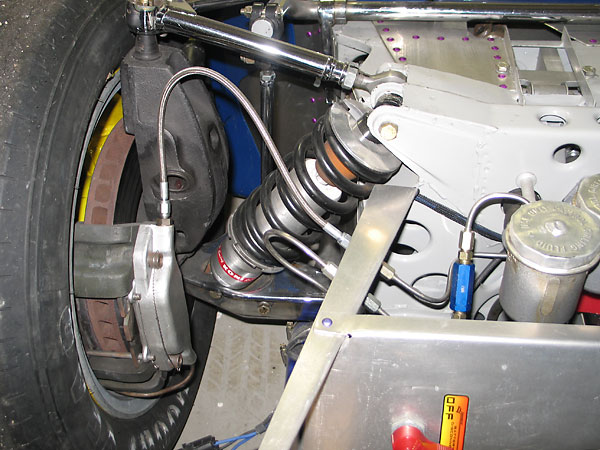
�
12.5" vented brake rotor.
�
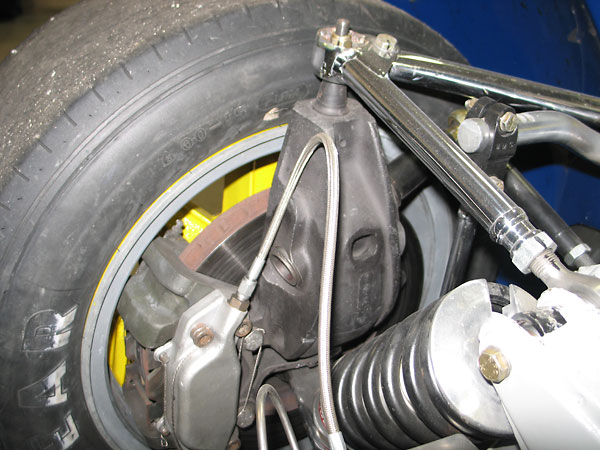
�
Upright assembly... note the simple and easily replaceable tubular steering arm.
�
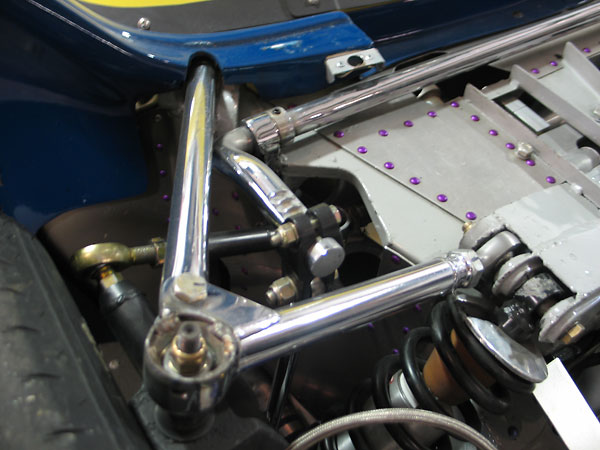
�
Upper control arm.
�
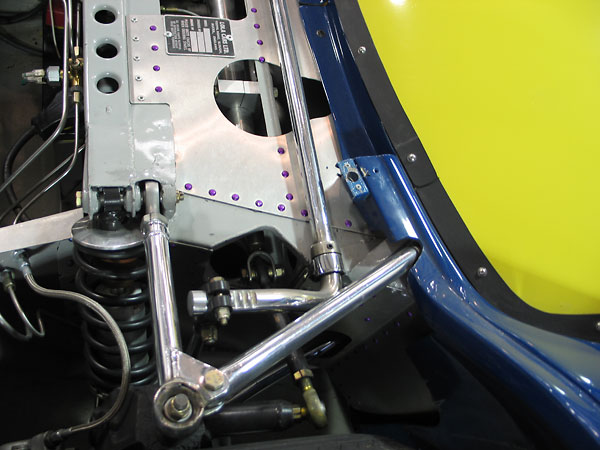
�
In plan view, upper and lower control arms are of essentially similar geometry. Loads on the control arms
�
are highest during hard braking. In that situation, the upper-rear link is in tension and the lower-rear link
�
is in compression. With this geometry, the lower-rear link needs to be of relatively robust construction
�
to resist bending loads (which could induce vibration, steering effects, or buckling), as indeed it is.
�
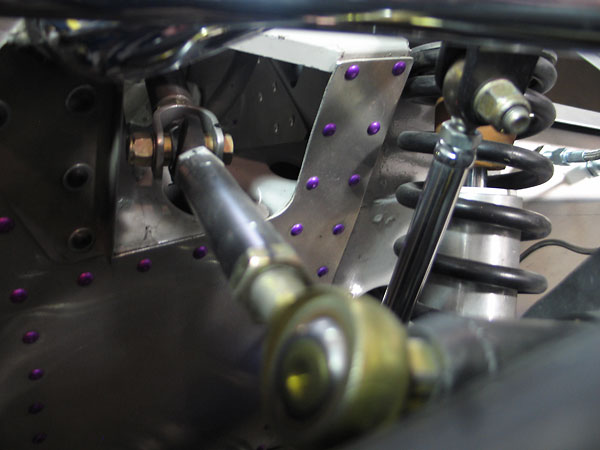
�
Close-up view of the steering link.
�
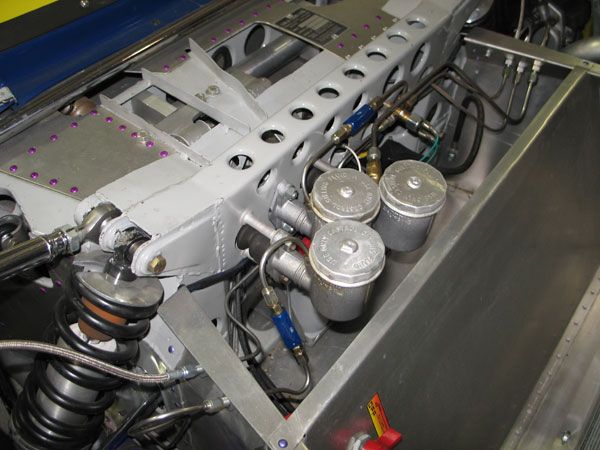
�
Girling master cylinders.
�
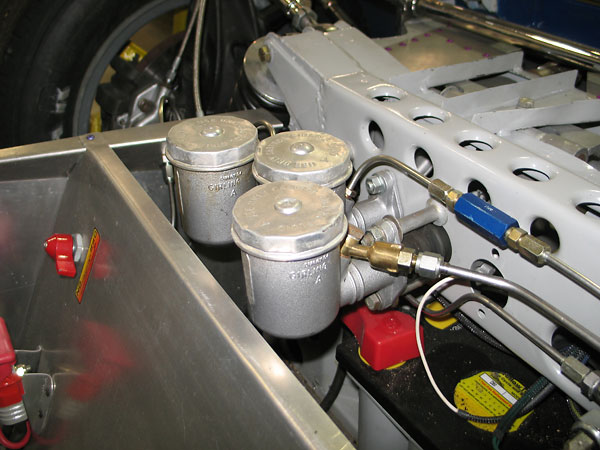
�
The blue anodized aluminum part shown here is a Wilwood residual pressure valve. These are a relatively
�
modern addition, used to improve brake pedal feel at the expense of a very minute amount of friction.
�
As the brake rotors spin, they tend to push the caliper pistons away. Residual pressure valves simply
�
keep a little extra fluid pressure behind the piston to resist the gap from opening up as far.
�
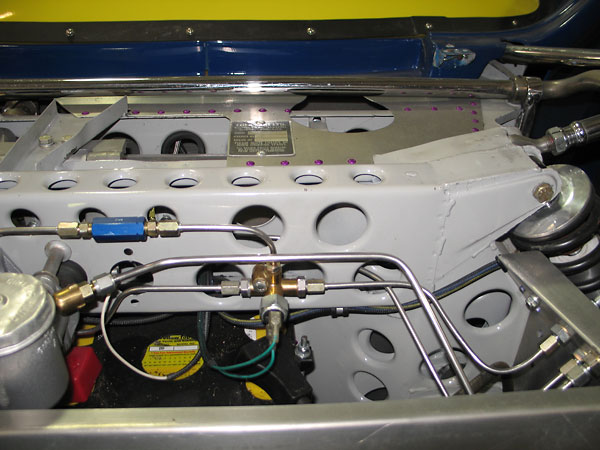
�
A hydraulic brake light switch has been installed on the front brake t-fitting.
�
�
Transaxle / Rear Suspension / Brakes
��
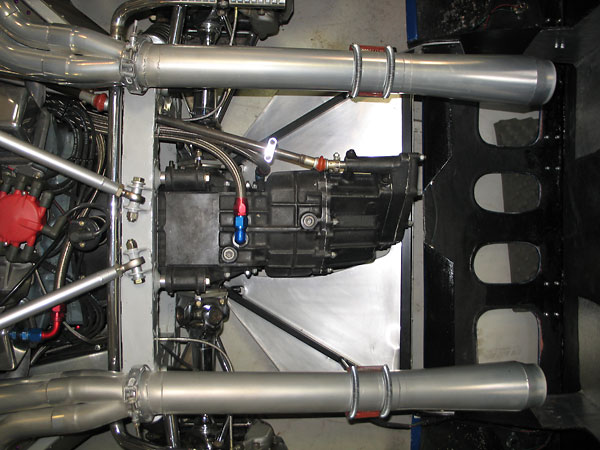
�
This is the four speed, 125 pound version of Hewland transaxle, known as an LG500. A five speed, 136
�
pound (LG600) version was also available. The two Hewland transaxles both had magnesium casings.
�
An elaborate, fabricated steel structure supports both transaxle and suspension mounting points.
�
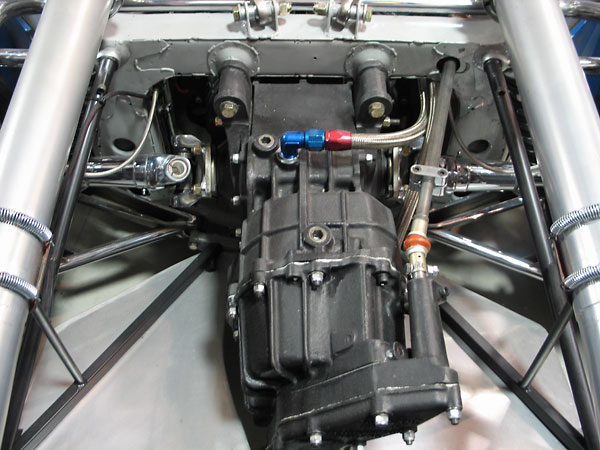
�
The lower A-arms are connected to the magnesium uprights in a "reversed" orientation, with two
�
outboard attachment points (and one inboard) per side. Not visible here, the lower A-arms are
�
also located by trailing links running forward to connections near the motor mounts.
�
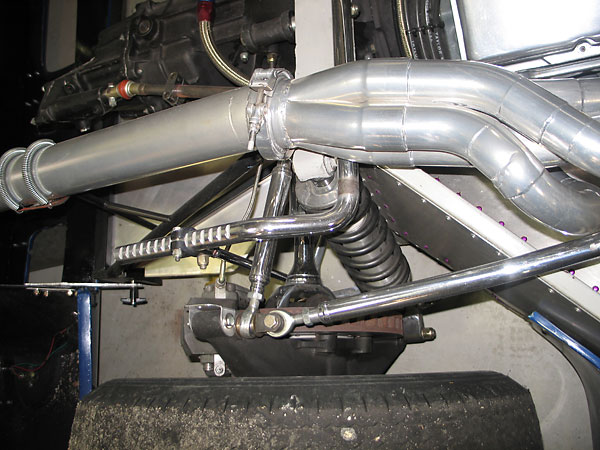
�
It's not really accurate to call the T70's rear structure either a "space frame" or a "monocoque"
�
because it utilizes a mix of tubular members and elaborately formed sheetmetal components. Note
�
also the anti-sway bar's adjustment feature and that the rear brakes are just inboard of the uprights.
�
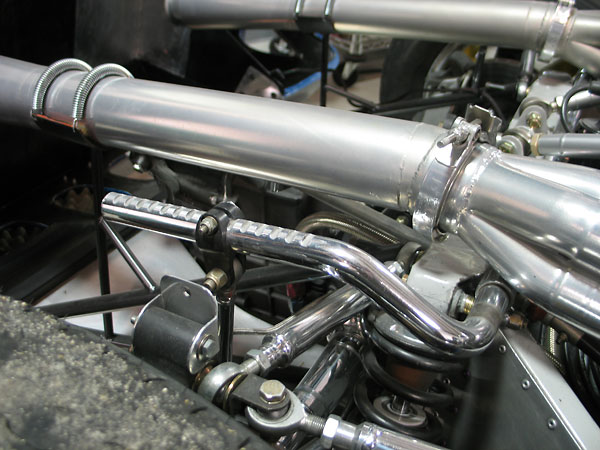
�
An interesting fact about original Lola T70 suspension links is that they didn't utilize reverse-threaded
�
Heim joints! Even small alignment adjustments required temporarily disconnecting one end of the link.
�
(Heim jointed, adjustable length suspension links were still pretty new. They first appeared on the
�
brilliant little 1958 Cooper Climax racecars that raced in both Formula One and Formula Two.)
�
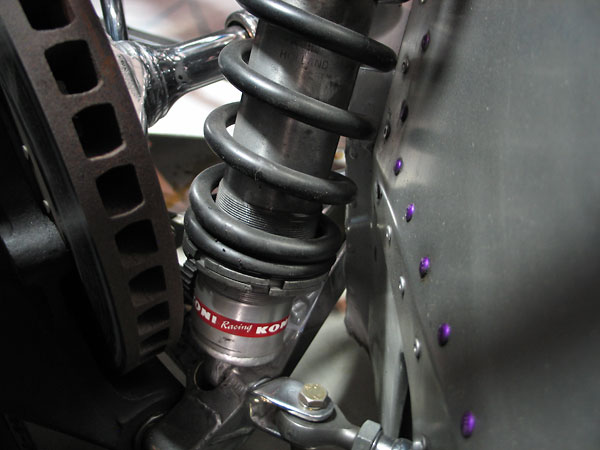
�
KONI 12-way adjustable shock absorber.
�
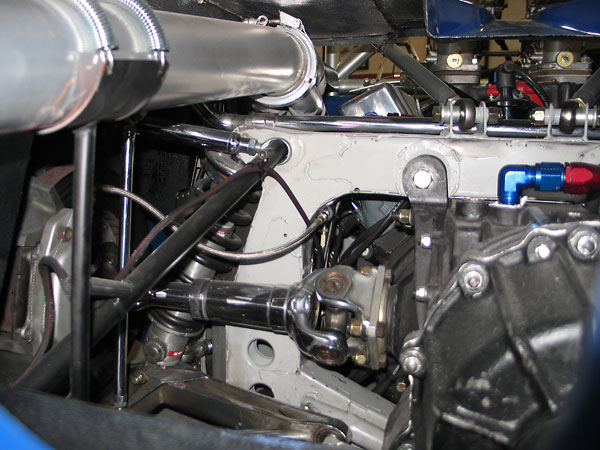
�
Inboard and outboard u-joints for articulation, plus splined slip joints between them to take up "plunge".
�
Although this design is typical for racecars of the T70's era, many designers experimented with other
�
designs (e.g. rubber "donuts") because slip joints were prone to binding which severely affected handling.
�
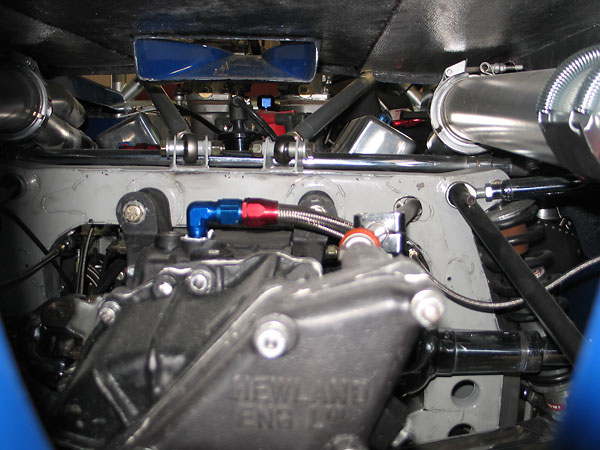
�
One more peek underneath the bodywork.
�
�
Cockpit / Controls
��
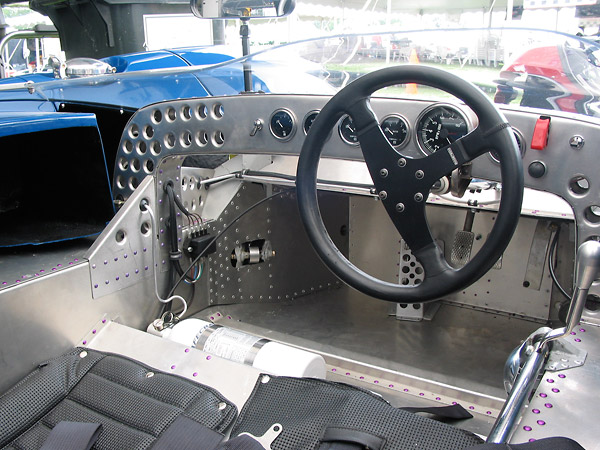
�
Quite lightweight and stiff, the whole center part of the Mk3 chassis (alternatively called a "punt" or a "tub"),
�
is made of aluminum. By contrast, the spot-welded steel tubs of Mk1 T70s weigh about seventy pounds
�
more, but Lola determined steel provided no additional torsional rigidity or safety in this application.
�
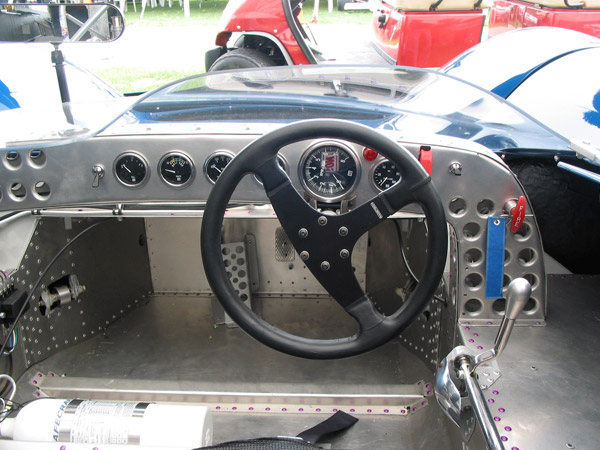
�
Fabricator Bill Scott conceived the distinctive "cowl arch" which differentiated Penske Racing's T70s.
�
Left: bottle for the Safecraft Safety Equipment fire extinguisher system. Right: the switch to activate it.
�
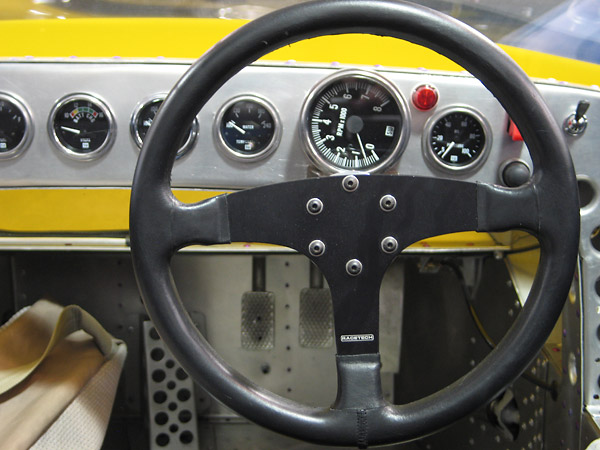
�
Racetech Design Ltd. still makes their excellent, lightweight steering wheels in England.
�
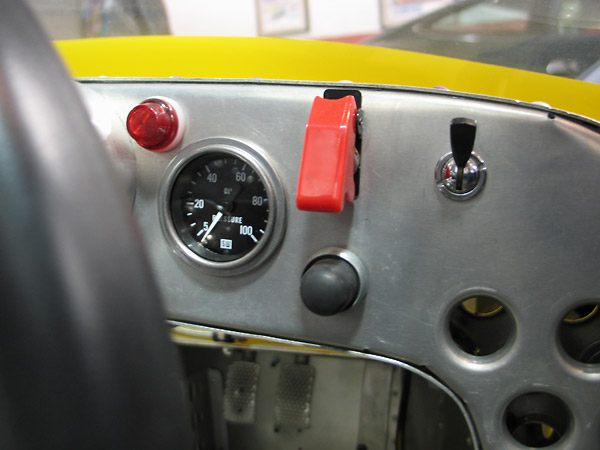
�
The car is equipped with Stewart Warner gauges. (Shown here: engine oil pressure gauge, 5-100psi.)
�
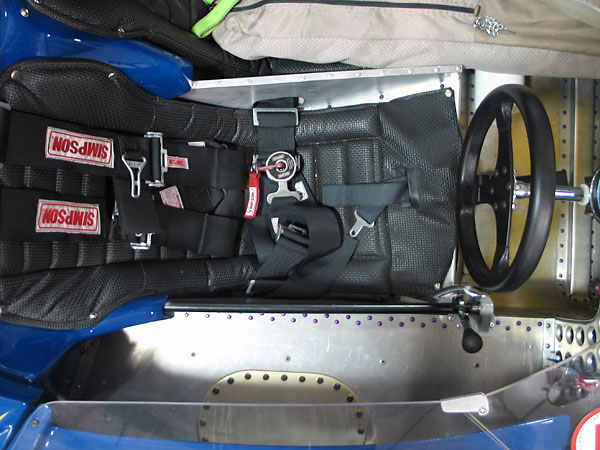
�
Lola used color-coded, military-spec, solid aluminum rivets throughout the T70. To accurately recreate
�
the vintage appearance of this racecar, Abacus Racing sent new rivets out to be re-anodized in the
�
correct shades of purple and lavender, then carefully matched rivet colors to locations on the chassis.
�
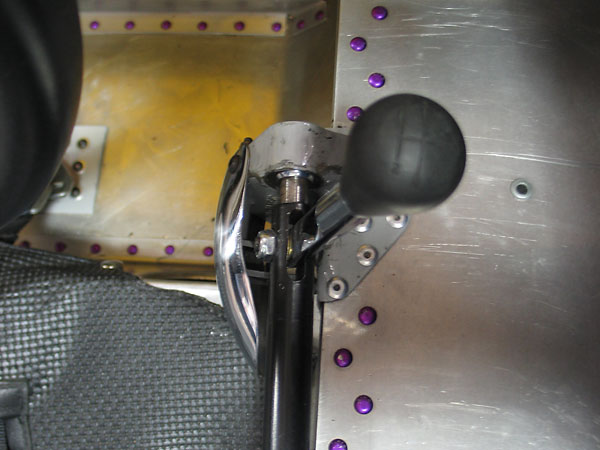
�
This is a different shifter than I saw at Road America. I wonder why? Looks like an MGB shifter knob!
�
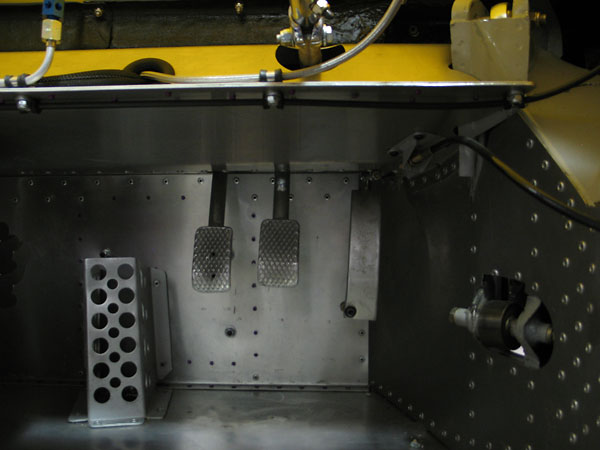
�
Left: a spray nozzle for the central fire extinguisher system, and also a "dead pedal".
�
Right: rear mounts for both upper & lower front control arms are accessed from inside.
�
�
Exterior / Body
��
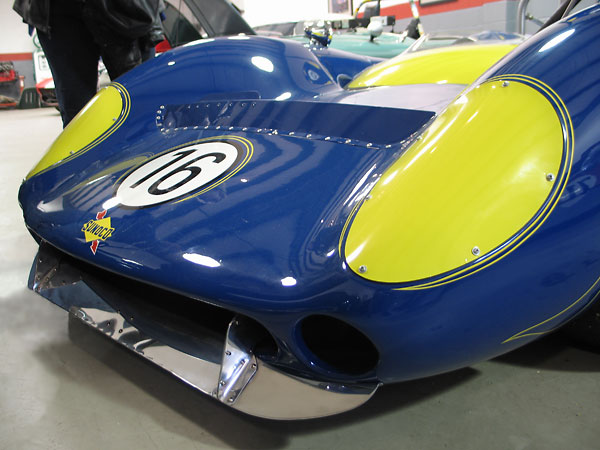
�
Mk3 Lola T70's (like this one) have a one-piece front clip, whereas Mk2 cars had a two-piece nose.
�
The brake cooling ducts were apparently optional; they only appear in some period photographs.
�
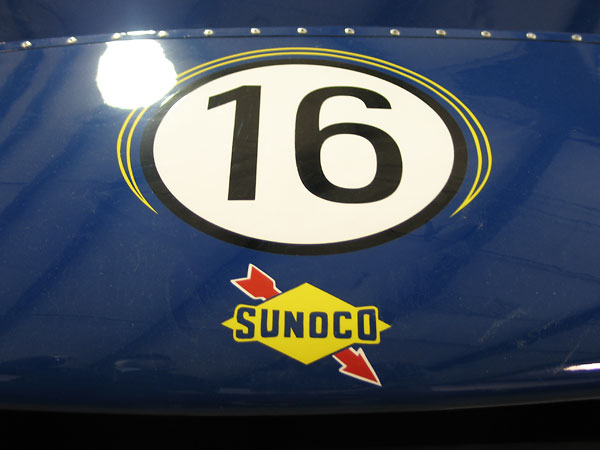
�
Mark Donohue's preferred racing number was 6. Number 16 was assigned to teammate George Follmer.
�
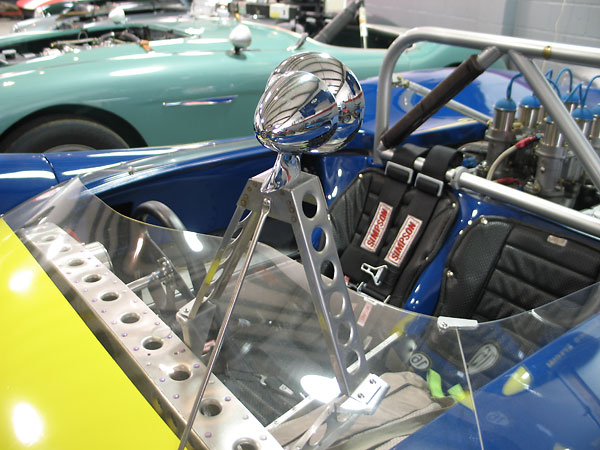
�
Penske Racing utilized tall, fabricated tripod mirror mounts and bullet style mirrors on their T70's.
�
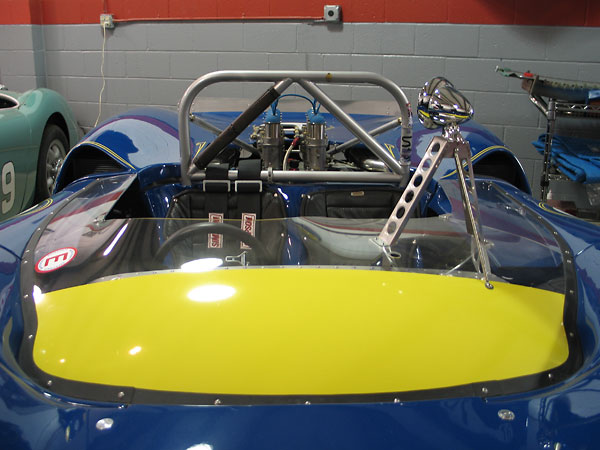
�
The (yellow) windscreen film doesn't effect driver's view, but it makes reading the gauges a little easier.
�
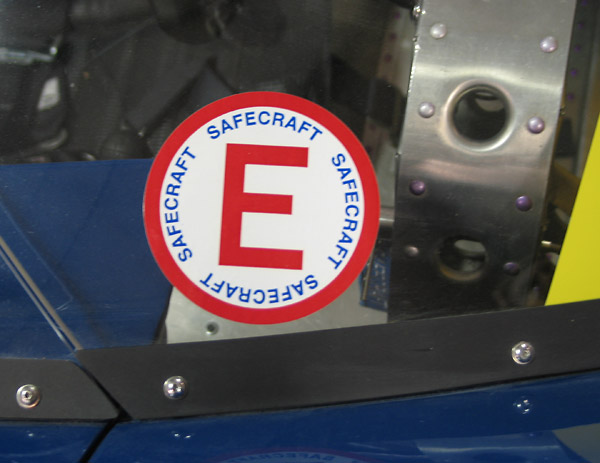
�
This decal would help track staff locate the fire extinquisher system switch in the event of an emergency.
�
The electrical system's master disconnect switch is mounted forward, in the radiator's exhaust vent.
�
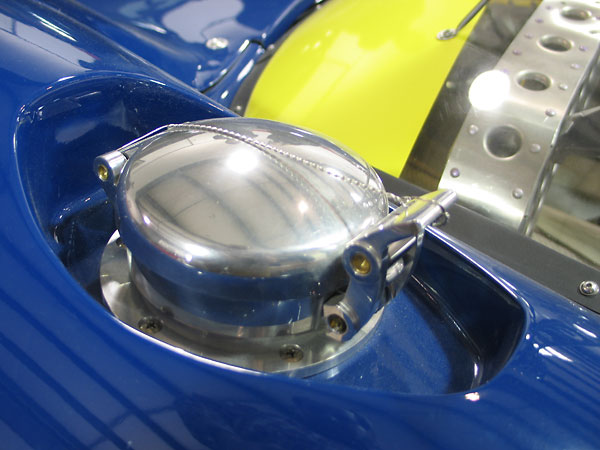
�
Since a modern fuel cell (with its own cap) has been installed, the original fuel filler is just for looks.
�
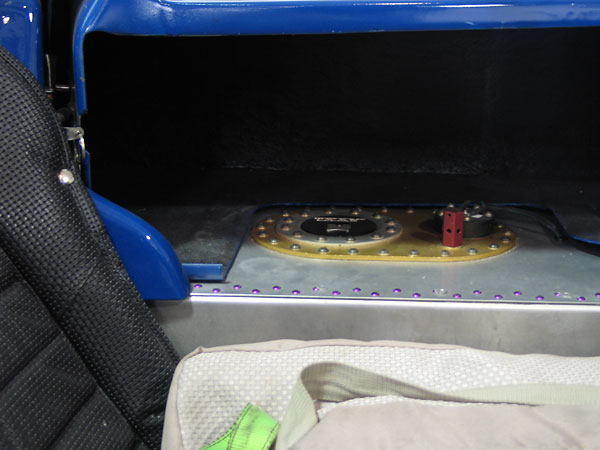
�
With the 1967 Can-Am season, two important new safety requirements came into effect. All competing
�
cars were required to have impact resistant fuel cells and dual shoulder harnesses. Lola T70's already
�
came with twin rubber-bladder cells with a combined capacity of 60 gallons (370 pounds). For safety
�
reasons, the left hand cell shown here has been updated, and the right-hand cell has been removed.
�
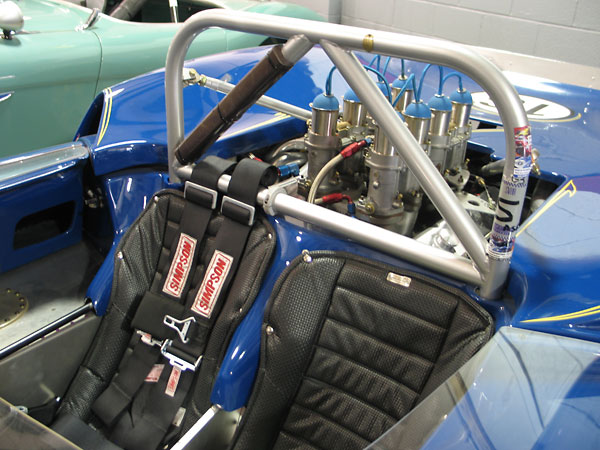
�
Does this safety equipment look "period correct" to you? Well, in 1967 the roll hoop would have been
�
about six inches shorter and it would have been a simple single hoop (with no diagonal braces at all.)
�
Instead of three inch wide shoulder belts, most 1967 vintage Can-Am cars used one inch wide belts.
�
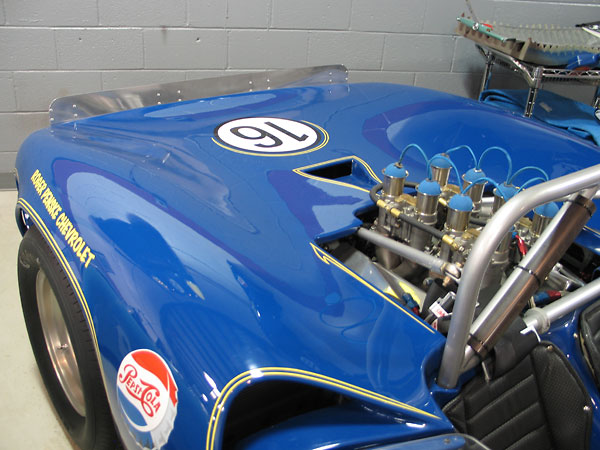
�
A low-mounted rear spoiler was used by Penske Racing in 1966...
�
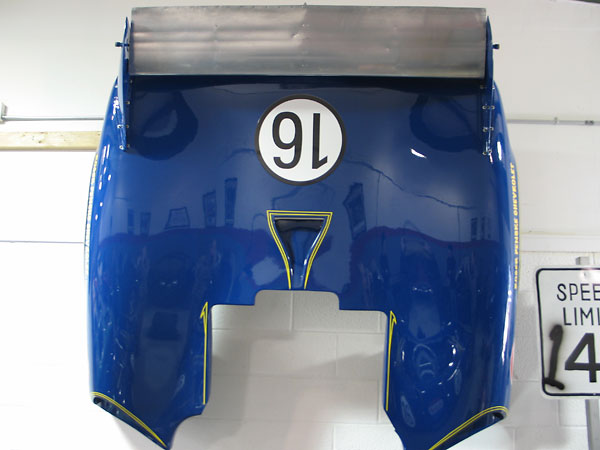
�
... but for 1967 they switched over to a rear wing, as shown here.
�
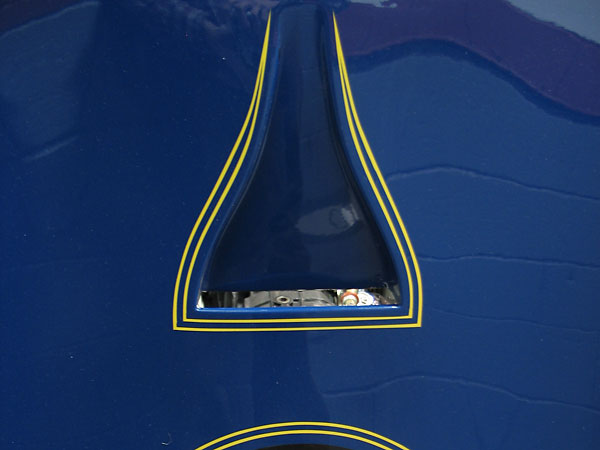
�
A NACA duct is used to draw air through the bodywork without disturbing laminer airflow.
�
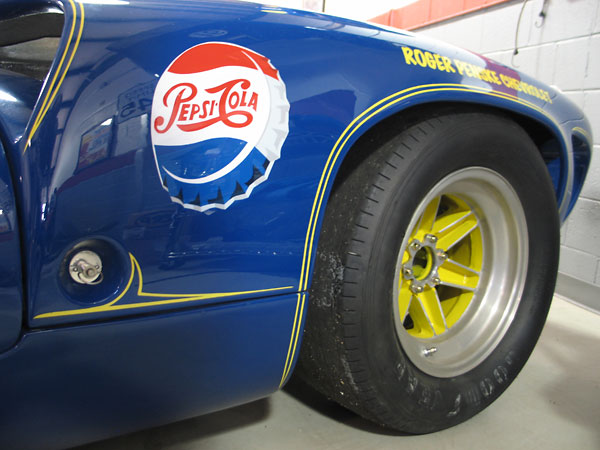
�
Quick-release, locking, 4130 steel "Pip pins" (as shown at left) restrain the body from hinging rearward.
�
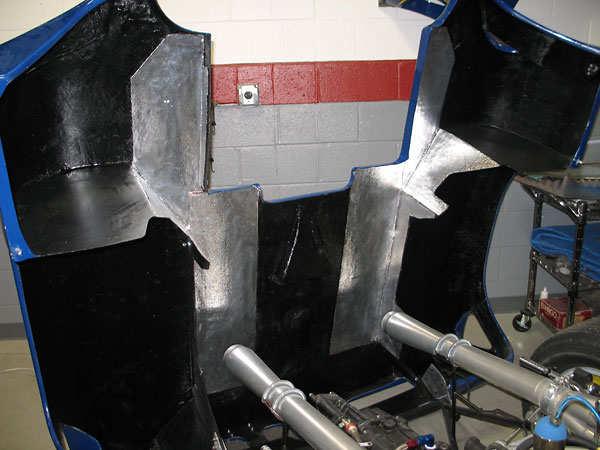
�
This photo shows what the underside of the fiberglass bodywork looks like. It's quite lightweight!
�
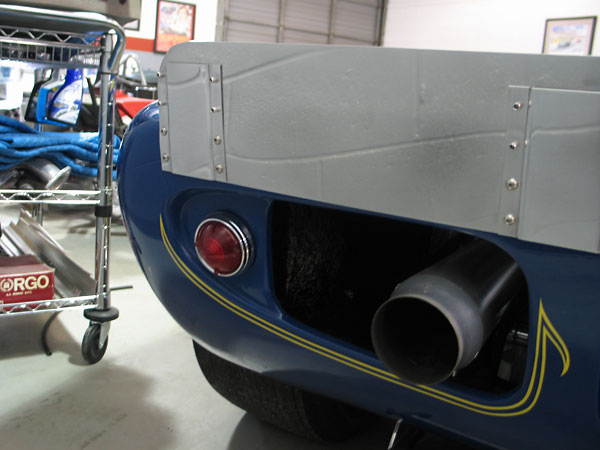
�
With low-mounted spoiler the car closely resembles Mark Donahue's T70 Mk2, in which he won 1 of 6 1966
�
Can-Am races. (Donahue finished 2nd in points in 1966 to John Surtees, who won 3 races in his T70 Mk2.)
�
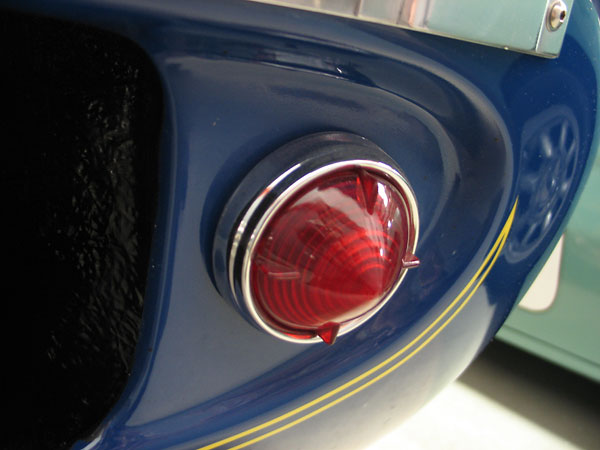
�
�
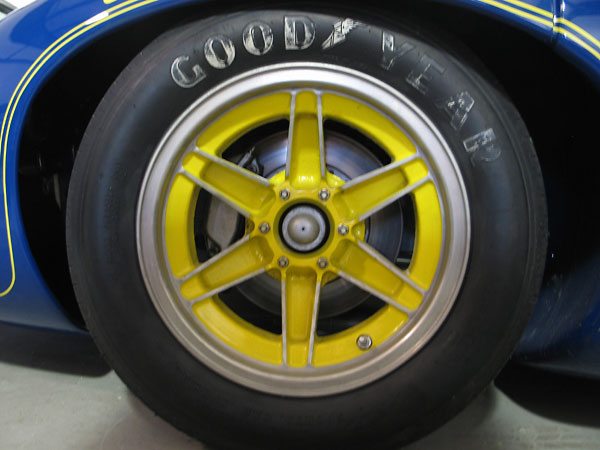
�
Original Lola magnesium wheels (15x8 front and 15x10 rear) and Goodyear "Blue Streak" tires.
�
(By way of contrast, the McLaren M6A's of 1967 all raced on 15x13.5 rear wheels!)�
| Notes: | |||||||
| (1) | �
Roger Penske Racing purchased chassis number SL.73/126 from John Mecom (Lola's U.S. �
distributor, located in Houston Texas) in August 1967. SL.73/126 was supplied to �
Penske Racing as an empty chassis, with no engine or transaxle included. The car was �
completed and prepared for racing after an accident, but the historical record �
is a little cloudy about which specific accident prompted its entry into service. �
Mark Donohue's 1966 Lola T70 Mk2 (SL.71/47) was badly damaged during testing of Firestone �
tires and Airheart brakes on or about July 19, 1967. On the other hand, George �
Follmer had a significant accident on September 22, 1967 while practicing at �
Mosport. Follmer's crashed T70 was repaired well enough to race the very next day �
and even to finish sixth. However, some sources report that upon returning to the �
Penske shop, Follmer's chassis was judged too damaged for continued use. It was a �
very busy time, with three Can-Am races in just one month! After one accident or �
the other, SL.73/126 entered service with Penske Racing.�
� | ||||||
�
The "outdoor" photos shown here are from July 2008, when Bill Thumel and Lola T70 Mk3 number �
SL.73/126 participated in the Kohler International Challenge (SVRA-sanctioned vintage races) at �
Road America in Elkhart Wisconsin. The "indoor" photos are from February 2009 when BritishV8 �
viewed the car at Bill's company, Abacus Racing, in Virginia Beach Virginia. All photos shown �
here are by Curtis Jacobson, and are for exclusive use by BritishRaceCar.com. Copyright 2010. �
All rights reserved.
�
| If you liked this article, you'll probably also enjoy these: | �|||||
 | �
Tom Grudovich 60 Lola Mk.1 | �
 | �
Eric Haga 70 Lola T190 | �
 | �
Scott Hughes 71 McLaren M8F | �
| You're invited to discuss anything you've seen here on The British Racecar Motorsports Forum! | �|||||
�
Notice: all the articles and almost all the photos on BritishRacecar.com are by Curtis Jacobson.
�
(Photos that aren't by Curtis are explicitly credited.) Reproduction without prior written permission is prohibited.
�
Contact us to purchase images or reproduction permission. Higher resolution images are optionally available.
�

 �
�